- Understanding Hydrangeas: A gardener’s perspective
- Hydrangea Varieties
- Growing Conditions
- Color Changes
- Pest and Disease Control
- Conclusion
- Essential Tips for Growing Hydrangeas in Your Garden
- 1. Select the Right Variety
- 2. Provide the Right Growing Conditions
- 3. Planting and Pruning
- 4. Watering and Fertilizing
- 5. Mulching and Winter Care
- Choosing the Perfect Hydrangea: Exploring Different Types
- 1. Bigleaf Hydrangeas (Hydrangea macrophylla)
- 2. Panicle Hydrangeas (Hydrangea paniculata)
- 3. Oakleaf Hydrangeas (Hydrangea quercifolia)
- 4. Smooth Hydrangeas (Hydrangea arborescens)
- 5. Climbing Hydrangeas (Hydrangea petiolaris)
- Planting Hydrangeas: Step-by-step Guide for Beginners
- 1. Choose the Right Location
- 2. Prepare the Soil
- 3. Dig the Hole
- 4. Plant the Hydrangea
- 5. Mulch and Water
- 6. Prune and Fertilize
- 7. Monitor and Maintain
- Caring for Hydrangeas: Watering, Pruning, and Fertilizing Techniques
- Watering
- Pruning
- Fertilizing
- Propagating Hydrangeas: Growing New Plants from Cuttings
- 1. Selecting the Cuttings
- 2. Preparing the Cuttings
- 3. Planting the Cuttings
- 4. Providing the Right Conditions
- 5. Caring for the Cuttings
- 6. Transplanting the Rooted Cuttings
- Common Problems and Pest Control for Hydrangeas
- 1. Powdery Mildew
- 2. Leaf Spot
- 3. Aphids
- 4. Slugs and Snails
- 5. Deer
- Hydrangea as a Landscaping Element: Design Ideas and Inspirations
- 1. Hydrangea Hedges
- 2. Hydrangea Pathways
- 3. Hydrangea Focal Points
- 4. Hydrangea Containers
- 5. Hydrangea Borders
- 6. Hydrangea Color Schemes
- 7. Hydrangea Companions
- Q&A:
- What are some tips for gardening hydrangeas?
- How do I propagate hydrangeas?
- What are some popular types of hydrangeas?
- When should I prune hydrangeas?
- Can hydrangeas change color?
- Video: How to propagate hydrangeas from cuttings:: Grow::
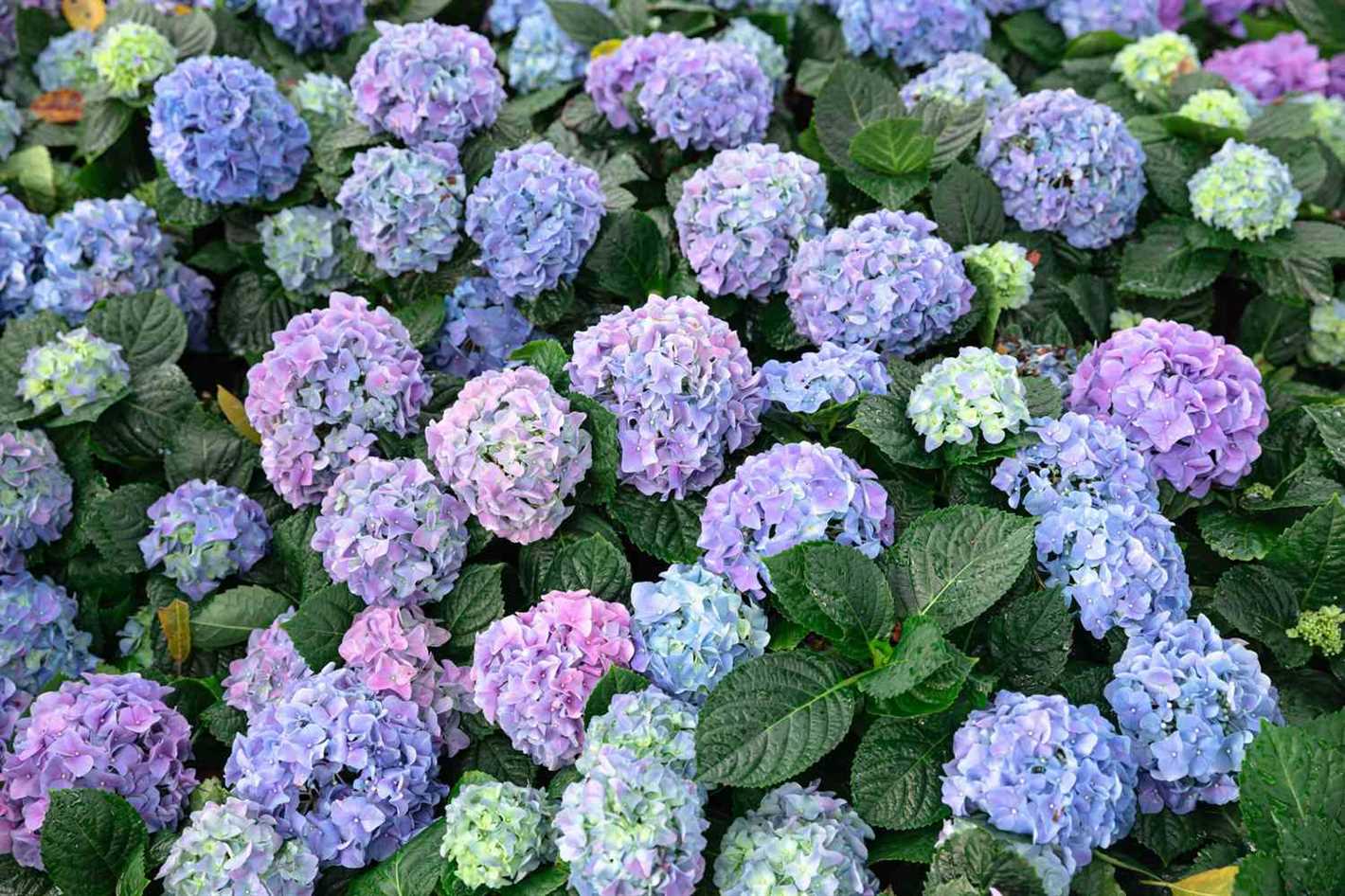
Welcome to “Hydrangea: Gardening, Propagation, Types – The Ultimate Guide”! If you are a gardening enthusiast or just someone who appreciates the beauty of flowers, you’ve come to the right place. In this comprehensive guide, we will explore everything you need to know about hydrangeas, from how to cultivate them in your garden to the different types and varieties available.
Hydrangeas are beloved for their stunning, showy blooms and ability to thrive in a wide range of climates. We will delve into the various gardening techniques that can help you grow healthy and vibrant hydrangeas, including planting, soil requirements, watering, and pruning tips. Whether you are a beginner or an experienced gardener, we will provide you with the knowledge you need to create a flourishing hydrangea garden.
Propagation is an essential aspect of gardening, and we will guide you through the process of propagating hydrangeas. From taking cuttings to dividing established plants, you will learn the techniques that will allow you to propagate your hydrangeas and expand your collection. With our step-by-step instructions, you will be able to successfully propagate these beautiful flowers and share their beauty with friends and family.
Finally, we will explore the many types and varieties of hydrangeas available. From the classic mophead hydrangeas to delicate lacecap varieties, each type offers its own unique charm and characteristics. We will discuss the different colors, flower shapes, and growth habits of these stunning plants, helping you choose the perfect hydrangea for your garden.
So, whether you’re aspiring to create a hydrangea paradise in your backyard or simply want to learn more about these fascinating flowers, our ultimate guide has got you covered. Let’s embark on this journey and discover the beauty and joy of hydrangeas together!
Understanding Hydrangeas: A gardener’s perspective
Hydrangeas are beloved by gardeners worldwide for their stunning and diverse blooms. With their large, vibrant flower heads, they add a pop of color and a touch of elegance to any garden. But there’s more to these beautiful plants than meets the eye. Understanding hydrangeas from a gardener’s perspective will help you make the most of their beauty and ensure their health and vitality.
Hydrangea Varieties
Hydrangeas come in a wide variety of species and cultivars, each with its own unique characteristics. Some popular hydrangea varieties include:
- Hydrangea macrophylla: Also known as mophead or lacecap hydrangea, this variety produces large rounded flower heads.
- Hydrangea paniculata: These hydrangeas have elongated cone-shaped flower heads and can have a tree-like growth habit.
- Hydrangea arborescens: This variety is known for its white, round flower heads and is commonly called smooth hydrangea.
- Hydrangea quercifolia: Oakleaf hydrangea gets its name from its oak-shaped leaves and produces cone-shaped flower heads.
Growing Conditions
Hydrangeas thrive in moist, well-drained soil with good organic content. They prefer partial shade to full sun, depending on the variety. It’s important to provide adequate water and ensure that the soil is not allowed to dry out. Regular fertilization can also help promote healthy growth and abundant blooms.
When planting hydrangeas, it’s crucial to consider the mature size of the variety and provide enough space for the plant to grow. Pruning hydrangeas at the right time and in the proper way will help maintain their shape and encourage new growth.
Color Changes
One of the fascinating aspects of hydrangeas is their ability to change colors. The color of hydrangea blooms can vary depending on the pH level of the soil. Acidic soil tends to produce blue or purple flowers, while alkaline soil results in pink or red blooms. By adjusting the pH of the soil, gardeners can manipulate the color of their hydrangea blooms to suit their preferences.
Pest and Disease Control
Like any other plant, hydrangeas are susceptible to certain pests and diseases. Common issues include powdery mildew, aphids, and spider mites. Regular inspection and early detection can help prevent these problems. Applying appropriate insecticides and fungicides when necessary can also help maintain the health of your hydrangeas.
Conclusion
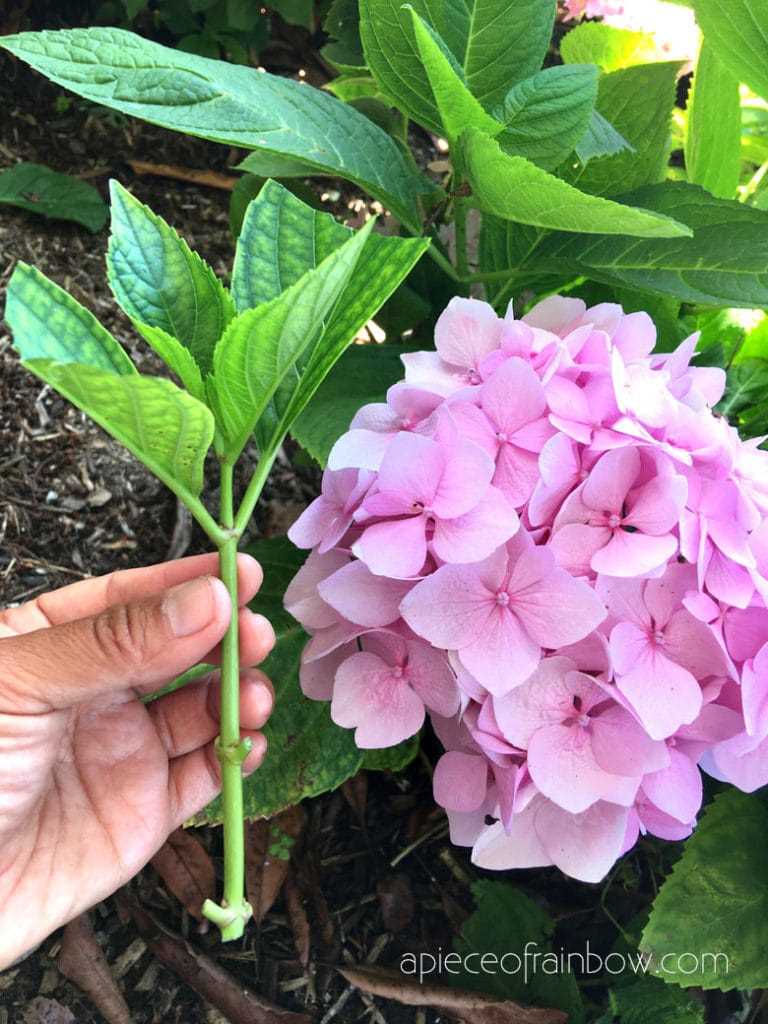

Understanding hydrangeas from a gardener’s perspective is essential for their successful cultivation. By selecting the right variety, providing appropriate growing conditions, and addressing pest and disease control, you can enjoy the beauty and abundance of hydrangea blooms in your garden year after year.
Essential Tips for Growing Hydrangeas in Your Garden
Growing hydrangeas is a popular choice among gardeners for their stunning blooms and versatility in different garden styles. Whether you’re a beginner or an experienced gardener, here are some essential tips to help you successfully grow hydrangeas in your garden.
1. Select the Right Variety
- Hydrangeas come in different varieties, including mophead, lacecap, oakleaf, and panicle types.
- Consider the climate and conditions of your garden to choose the right variety that will thrive in your area.
- Mophead and lacecap hydrangeas are popular for their large flower heads, while oakleaf hydrangeas offer beautiful foliage and panicle hydrangeas have cone-shaped flower clusters.
2. Provide the Right Growing Conditions
- Hydrangeas prefer well-draining soil with a pH level of 5.5 to 6.5.
- They thrive in partial shade or dappled sunlight, although some varieties can tolerate full sun.
- Ensure the soil remains consistently moist but not waterlogged.
- Amend the soil with organic matter, such as compost, to improve its fertility and moisture retention.
3. Planting and Pruning
- Plant hydrangeas in spring or early fall when the soil is warm and moist.
- Space the plants according to their mature size, usually 3 to 6 feet apart.
- Remove any dead or damaged branches and shape the shrub in late winter or early spring.
- Pruning requirements vary depending on the hydrangea variety, so consult specific guidelines for each type.
4. Watering and Fertilizing
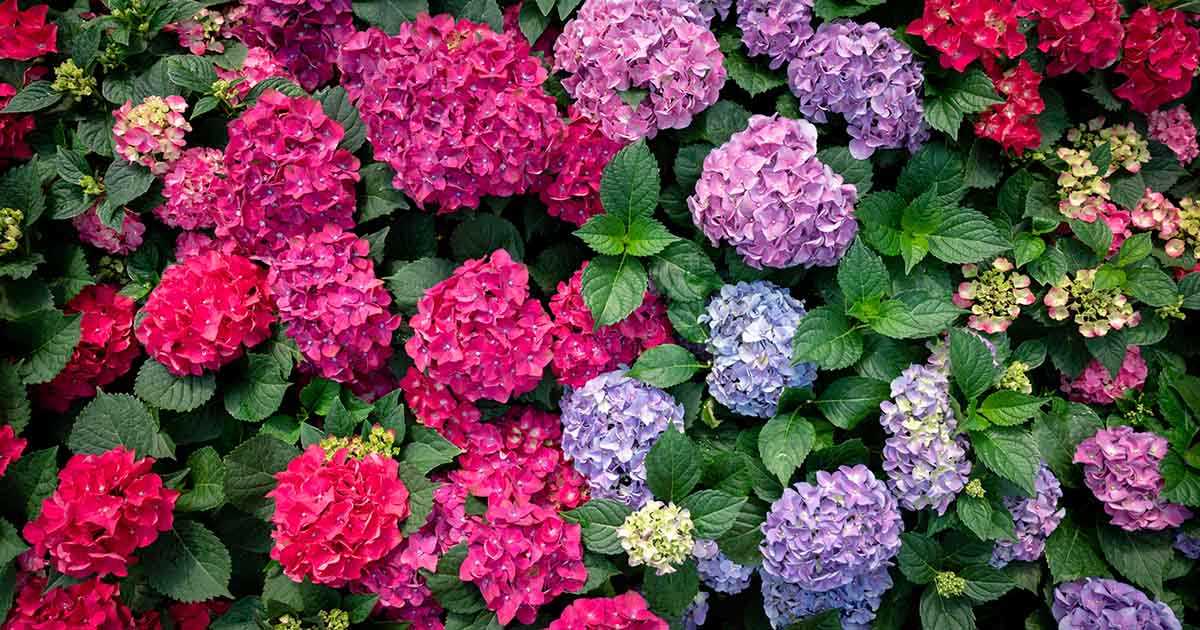

- Water hydrangeas regularly, especially during dry spells, to keep the soil consistently moist.
- Avoid overwatering or letting the soil become waterlogged.
- Fertilize hydrangeas in early spring and mid-summer with a balanced slow-release fertilizer.
- Follow the manufacturer’s instructions for proper application rates.
5. Mulching and Winter Care
- Apply a layer of organic mulch around the base of the hydrangea to conserve moisture and suppress weeds.
- Keep the mulch a few inches away from the stem to prevent rot.
- In colder climates, protect the hydrangea during winter by covering it with burlap or using a protective plant cover.
- Prune any dead or damaged branches in early spring before new growth emerges.
By following these essential tips, you can enjoy the beauty and charm of hydrangeas in your garden. Experiment with different varieties and planting locations to create a stunning display of color and texture.
Choosing the Perfect Hydrangea: Exploring Different Types
If you’re considering adding hydrangeas to your garden, it’s important to choose the right type for your landscape. Hydrangeas come in a variety of colors, sizes, and growth habits, each with its own unique characteristics. In this guide, we will explore some of the most popular types of hydrangeas to help you make an informed decision for your garden.
1. Bigleaf Hydrangeas (Hydrangea macrophylla)
Bigleaf hydrangeas are one of the most common types and are valued for their large, showy flower heads. They are known for their ability to change color based on the soil pH, with pink flowers in alkaline soil and blue flowers in acidic soil. These hydrangeas can grow as either mophead or lacecap varieties, with mophead featuring dense, round flower clusters and lacecap having flat clusters with a ring of larger flowers in the center.
2. Panicle Hydrangeas (Hydrangea paniculata)
Panicle hydrangeas are known for their large, conical flower heads that start off white or cream-colored and gradually turn pink or even dark maroon as they mature. They are incredibly hardy and can tolerate a wide range of growing conditions, making them a popular choice for many gardeners. Some popular varieties include ‘Limelight’ and ‘PeeGee’.
3. Oakleaf Hydrangeas (Hydrangea quercifolia)
Oakleaf hydrangeas are named for their distinct foliage, which resembles the leaves of oak trees. In addition to their unique foliage, they produce cone-shaped flower clusters that start off white and gradually turn pink or maroon as they age. These hydrangeas are native to the southeastern United States and are well-suited to grow in hot and humid climates.
4. Smooth Hydrangeas (Hydrangea arborescens)
Smooth hydrangeas are prized for their large, rounded flower heads and their ability to bloom consistently even in colder climates. The most well-known variety is ‘Annabelle’, which produces white flower clusters that can reach up to 12 inches in diameter. These hydrangeas are easy to grow and are often used as foundation plantings or in flower borders.
5. Climbing Hydrangeas (Hydrangea petiolaris)
Climbing hydrangeas are unique in that they can actually climb and attach themselves to vertical surfaces, such as walls or fences. They produce clusters of white flowers and are valued for their ability to provide vertical interest in the garden. However, they can take several years to become established and start blooming, so patience is key when growing this type of hydrangea.
When choosing the perfect hydrangea for your garden, consider factors such as the size of your landscape, the desired color of the flowers, and the growing conditions in your area. By selecting the right type of hydrangea, you can enjoy the beauty and charm of these versatile plants in your garden for years to come.
Planting Hydrangeas: Step-by-step Guide for Beginners
Hydrangeas are beautiful flowering plants that can add a touch of elegance to any garden. If you’re a beginner and want to start growing hydrangeas, follow this step-by-step guide to ensure successful planting:
1. Choose the Right Location
Hydrangeas prefer partially shaded areas with morning sun and afternoon shade. Avoid planting them in direct sunlight, as it can cause the leaves to wilt and burn. Select a spot in your garden that has well-draining soil and is protected from strong winds.
2. Prepare the Soil
Before planting hydrangeas, it’s important to prepare the soil properly. Hydrangeas prefer moist, well-draining soil that is rich in organic matter. You can improve the soil’s quality by adding compost or aged manure. Make sure to loosen the soil and remove any weeds or rocks.
3. Dig the Hole
Dig a hole that is twice as wide and just as deep as the root ball of the hydrangea. This will provide enough space for the roots to spread out. If you’re planting multiple hydrangeas, make sure to space them at least 3-6 feet apart.
4. Plant the Hydrangea
Place the hydrangea in the hole, making sure that the top of the root ball is level with the ground. Backfill the hole with soil, gently firming it around the roots. Water the plant thoroughly to help settle the soil.
5. Mulch and Water
Apply a layer of mulch around the base of the hydrangea to help retain moisture and control weeds. Water the plant regularly, especially during dry spells, to keep the soil moist but not waterlogged.
6. Prune and Fertilize
Prune your hydrangeas in late winter or early spring to remove dead or weak branches. Avoid heavy pruning, as it can reduce the plant’s ability to produce flowers. Fertilize your hydrangeas in spring and summer with a balanced slow-release fertilizer to promote healthy growth and vibrant blooms.
7. Monitor and Maintain
Regularly monitor your hydrangeas for any signs of pests or diseases. Treat any issues promptly to prevent them from spreading. Remove spent blooms to encourage new growth and prolong the flowering season.
By following these steps, you’ll be well on your way to growing beautiful and healthy hydrangeas in your garden. Enjoy the stunning blooms and the joy they bring to your outdoor space!
Caring for Hydrangeas: Watering, Pruning, and Fertilizing Techniques
Hydrangeas are beautiful and popular flowering plants that require proper care to thrive. Here are some essential techniques for watering, pruning, and fertilizing your hydrangeas.
Watering
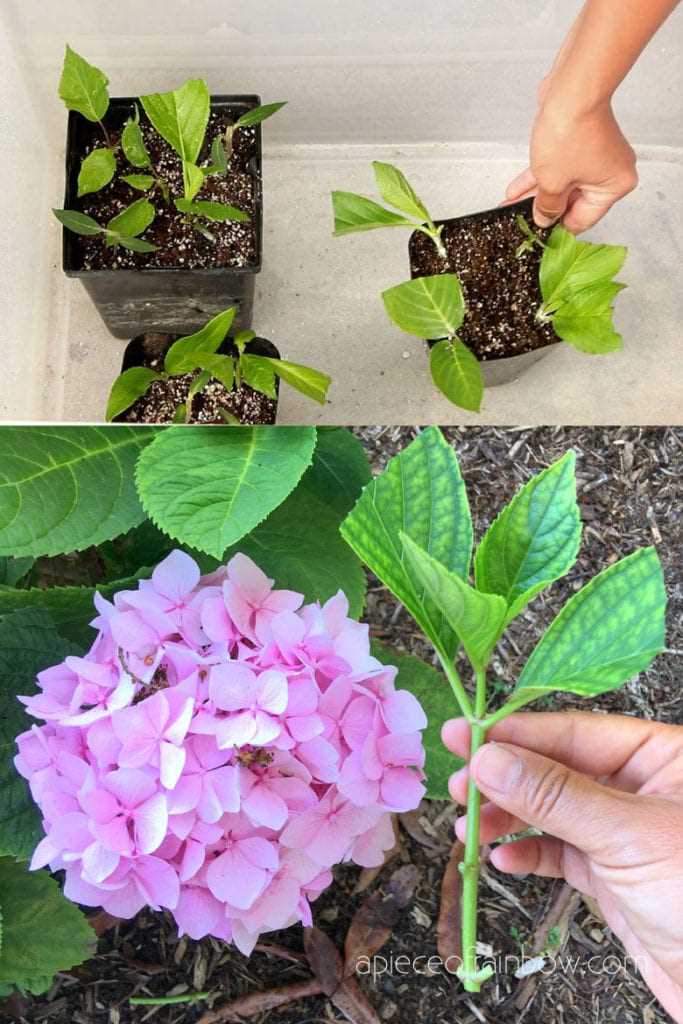

Hydrangeas require consistent and adequate watering to maintain their health and beauty. Here are some watering techniques to keep in mind:
- Water deeply and infrequently, providing enough water to reach the plant’s roots.
- Make sure the soil is well-drained to prevent waterlogged roots, which can lead to root rot.
- Water in the morning or evening when temperatures are cooler to minimize evaporation.
- During hot and dry periods, increase watering frequency to prevent dehydration.
Pruning
Pruning hydrangeas is essential for maintaining their shape and promoting healthy growth. Here are some pruning techniques to follow:
- Prune in late winter or early spring before new growth begins.
- Remove any dead, damaged, or diseased branches to prevent the spread of infections.
- For mophead and lacecap hydrangeas, prune the stems that have flowered to the first pair of healthy buds.
- For panicle and smooth hydrangeas, prune them to about one-third of their height to encourage bushier growth.
Fertilizing
Proper fertilization is crucial for the growth and flowering of hydrangeas. Here are some fertilizing techniques to consider:
- Use a balanced slow-release fertilizer in early spring to provide nutrients throughout the growing season.
- Apply fertilizer evenly around the base of the plant and water it in well.
- Avoid over-fertilizing, as it can cause excessive leaf growth at the expense of flowers.
- Consider using organic fertilizers or compost to provide natural and slow-release nutrients to the soil.
By following these watering, pruning, and fertilizing techniques, you can ensure that your hydrangeas thrive and produce abundant, beautiful blooms.
Propagating Hydrangeas: Growing New Plants from Cuttings
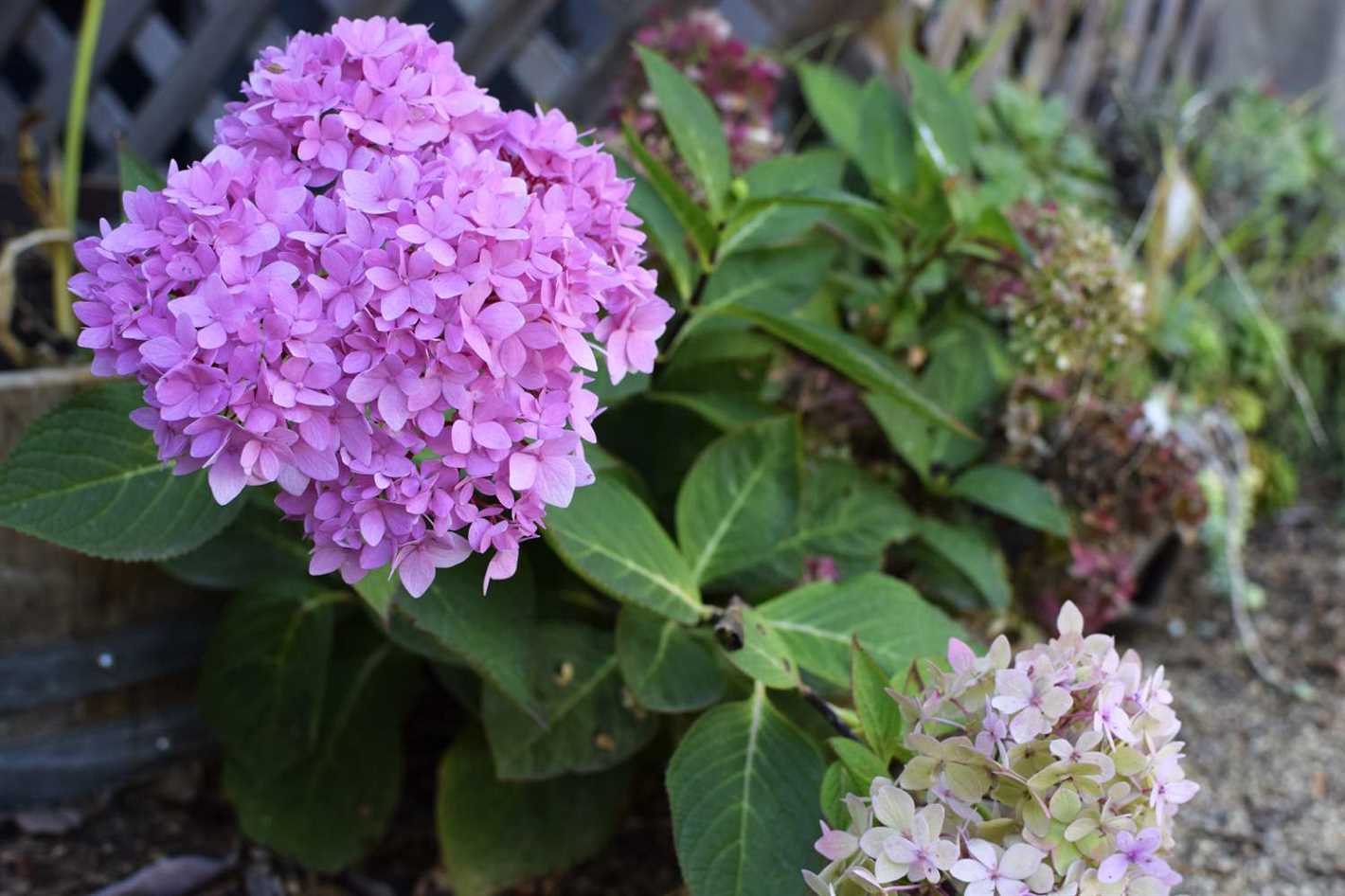

Propagating hydrangeas from cuttings is a great way to grow new plants and expand your hydrangea collection. This method is relatively easy, and it allows you to create new plants that are genetically identical to the parent plant. Here are the steps to propagate hydrangeas from cuttings:
1. Selecting the Cuttings
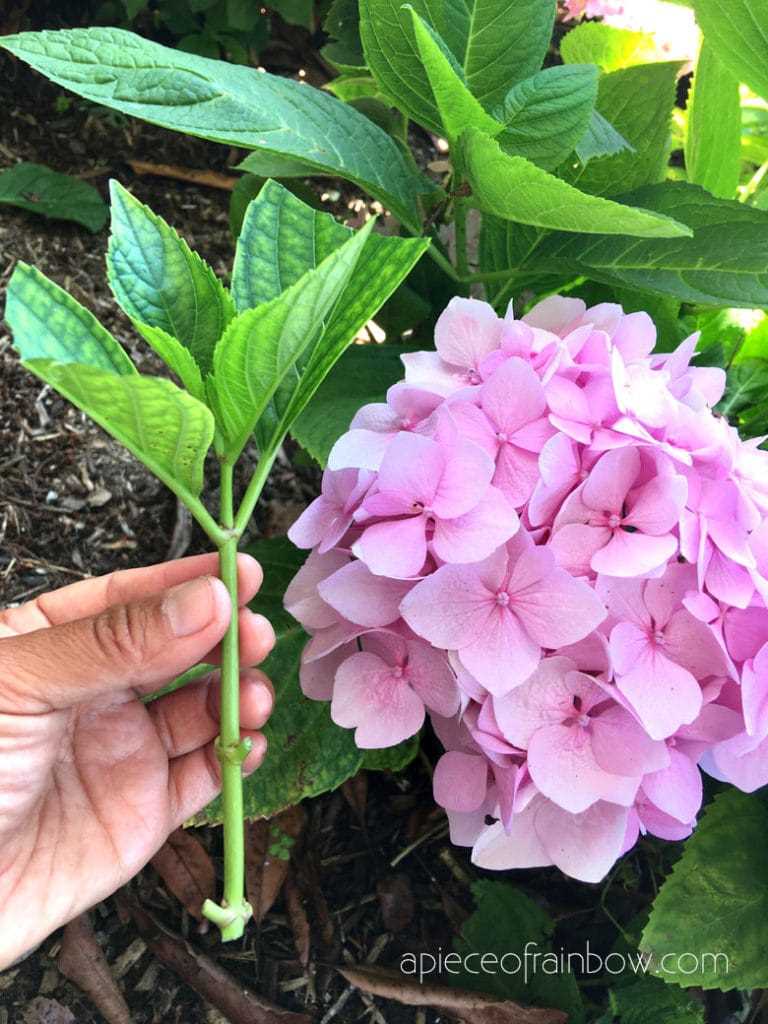

Choose healthy, non-flowering stems for your cuttings. Look for stems that are about 6 inches long and have several healthy leaves. Make sure to use clean, sharp pruning shears to avoid damaging the plant.
2. Preparing the Cuttings
Remove the leaves from the bottom half of the cutting to reduce water loss and prevent rot. Leave a few leaves at the top for photosynthesis. Dip the bottom of the cutting in rooting hormone powder to encourage root growth.
3. Planting the Cuttings
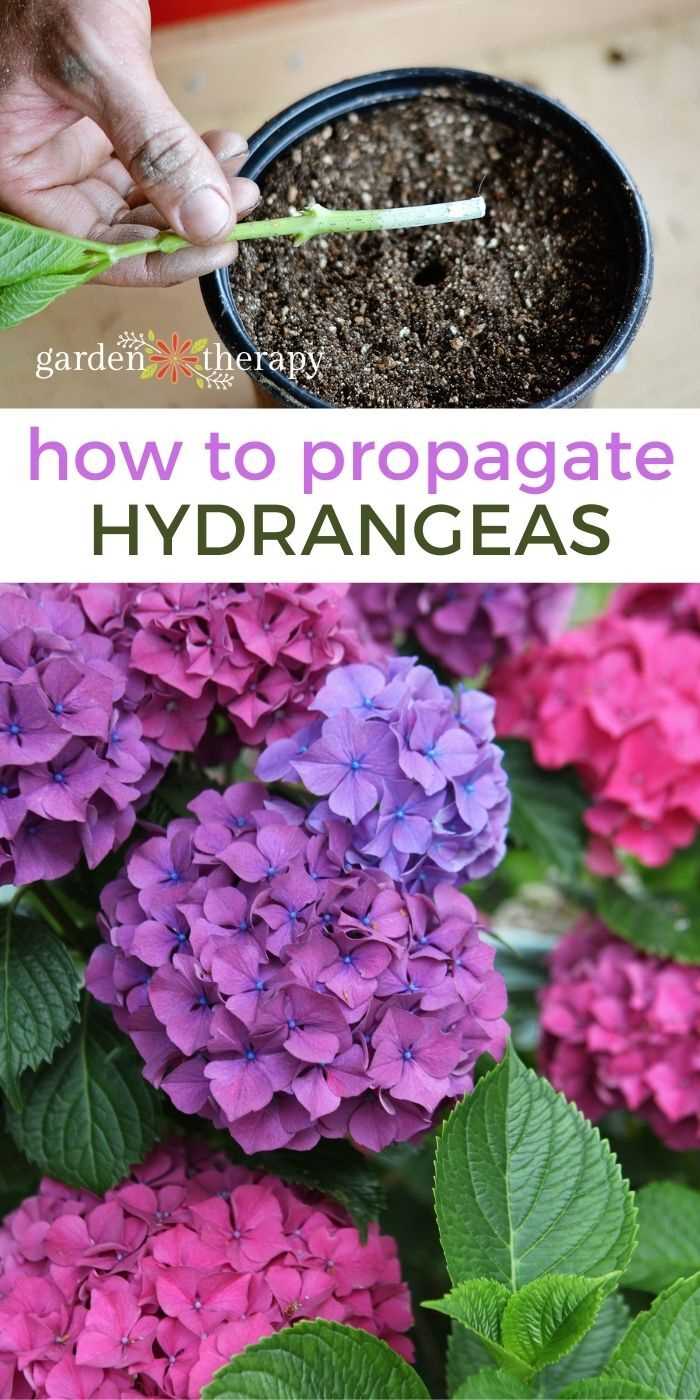

Fill a pot or tray with a well-draining rooting medium, such as perlite or vermiculite. Make holes in the medium and insert the cuttings, leaving about half of the cutting above the surface. Firmly press the medium around the cuttings to ensure good contact.
4. Providing the Right Conditions
Place the cuttings in a warm and humid environment. You can cover them with a plastic bag or use a propagating case to create a mini greenhouse effect. Keep the medium moist but not waterlogged, and provide indirect light to encourage root development.
5. Caring for the Cuttings
Check the cuttings regularly for signs of disease or rot. Remove any yellowing or wilting leaves and provide proper ventilation to prevent mold or mildew. Water the cuttings as needed to keep the medium consistently moist.
6. Transplanting the Rooted Cuttings
After 6-8 weeks, check for root development by gently tugging on the cuttings. If you feel resistance, it means roots have formed. At this stage, the cuttings can be transplanted into individual pots or directly into the garden. Provide them with the same care as mature hydrangea plants.
Propagation by cuttings is a reliable and rewarding method for growing new hydrangea plants. With a little patience and care, you can increase your hydrangea collection and enjoy the beauty of these beloved shrubs in your garden.
Common Problems and Pest Control for Hydrangeas
Hydrangeas are generally hardy plants, but they can still be susceptible to a few common problems and pests. Here are some issues you may encounter with hydrangeas and ways to control them:
1. Powdery Mildew
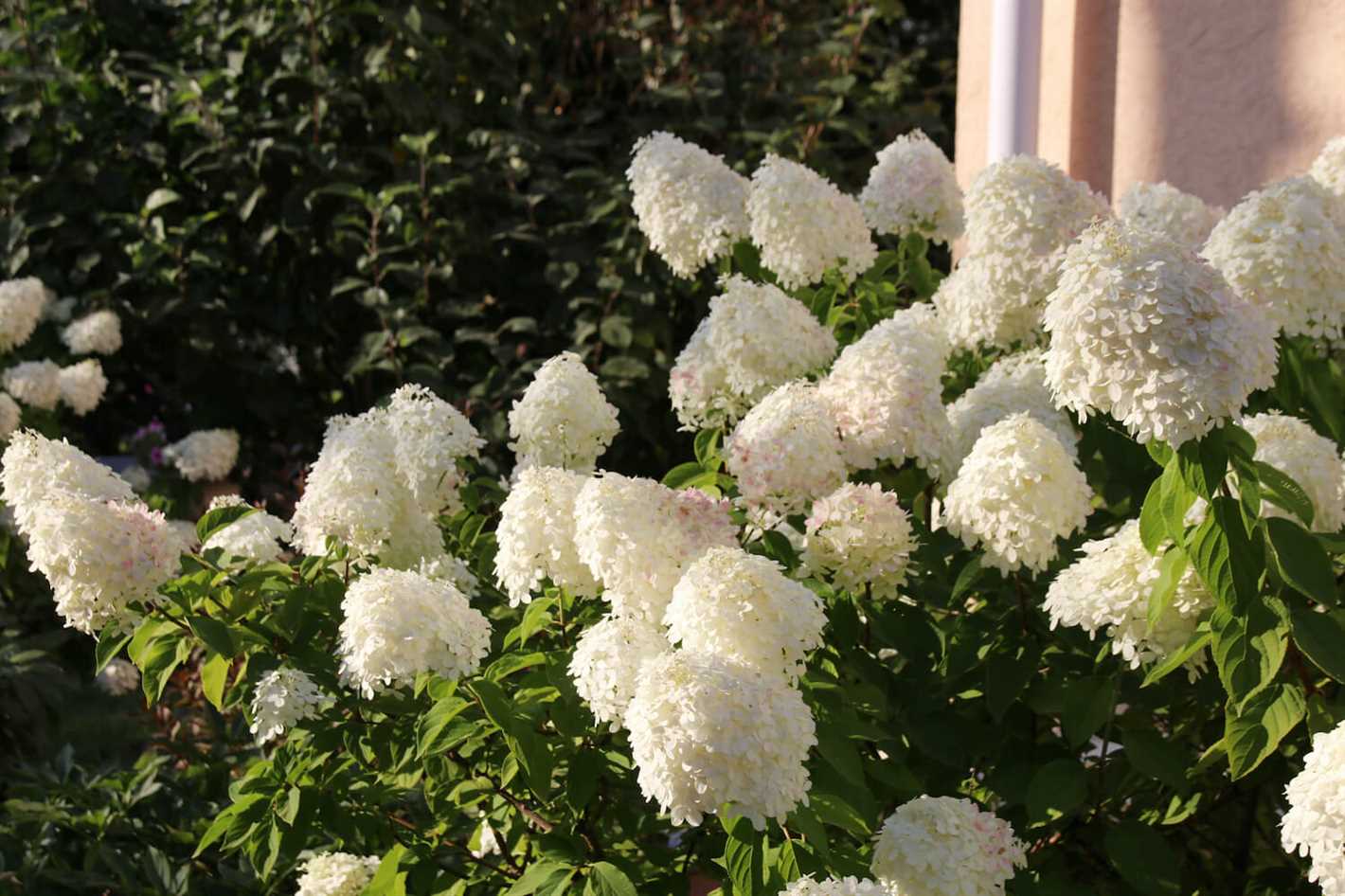

Powdery mildew is a fungal disease that affects many plants, including hydrangeas. It appears as a white, powdery substance on the leaves and stems. To control powdery mildew:
- Prune any infected branches or leaves and dispose of them in a sealed bag.
- Avoid overhead watering, which can promote the growth of powdery mildew.
- Apply a fungicide specifically for powdery mildew according to the manufacturer’s instructions.
2. Leaf Spot
Leaf spot is another fungal disease that can affect hydrangeas. It causes dark, circular spots on the leaves. To control leaf spot:
- Remove any infected leaves and dispose of them in a sealed bag.
- Avoid overhead watering and watering late in the day, as excess moisture can promote leaf spot.
- Apply a fungicide labeled for leaf spot according to the manufacturer’s instructions.
3. Aphids
Aphids are small insects that feed on the sap of plants, including hydrangeas. They can cause curling leaves and distorted growth. To control aphids:
- Spray the affected plants with a strong stream of water to dislodge the aphids.
- Introduce natural predators, such as ladybugs, to the garden to help control aphid populations.
- Apply an insecticidal soap or neem oil spray, following the instructions on the product label.
4. Slugs and Snails
Slugs and snails are common garden pests that can damage hydrangeas by eating holes in the leaves. To control slugs and snails:
- Remove any hiding places for these pests, such as stones or debris, near your hydrangeas.
- Place copper tape around the base of the plant, as slugs and snails are deterred by the electrical charge it produces.
- Apply organic slug and snail baits or traps, following the instructions on the product label.
5. Deer
Deer can be a big threat to hydrangeas, as they often browse on the leaves and flowers. To deter deer from your garden:
- Install a deer fence or use deer netting to keep them out of your hydrangea beds.
- Choose hydrangea varieties that are less appealing to deer, such as those with thicker or hairy leaves.
- Apply a deer repellent spray or scatter human hair or soap shavings around your hydrangeas.
By keeping an eye out for these common problems and pests and taking appropriate measures, you can ensure your hydrangeas stay healthy and vibrant.
Hydrangea as a Landscaping Element: Design Ideas and Inspirations
Hydrangeas are a versatile and beautiful addition to any landscape design. With their large, colorful blooms and lush green foliage, they can add drama and interest to any outdoor space. Whether you have a small garden or a sprawling backyard, hydrangeas can be incorporated into your landscaping in various ways to create stunning visual effects.
1. Hydrangea Hedges
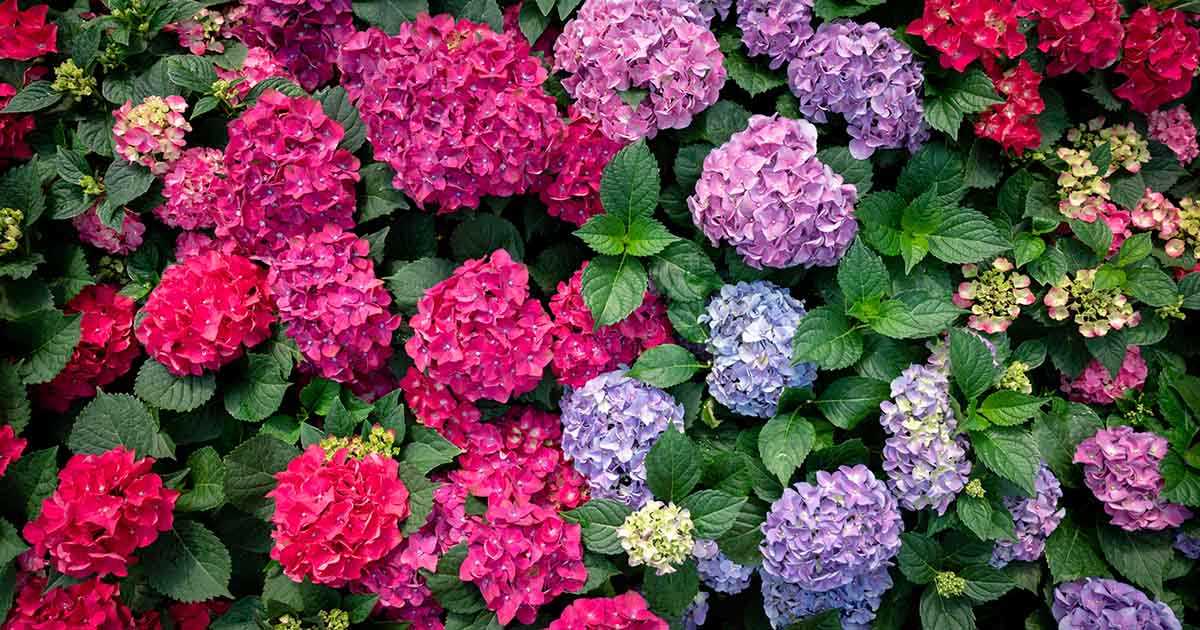

One popular way to use hydrangeas in landscaping is to create hedges or borders. Planting hydrangeas in a row can create a natural, colorful fence that separates different areas of your garden. You can choose to plant hydrangeas of the same color for a uniform look, or mix different varieties for a more eclectic vibe. Hydrangea hedges can provide privacy, a pop of color, and a sense of structure to your outdoor space.
2. Hydrangea Pathways
Another creative way to incorporate hydrangeas into your landscape design is to plant them along pathways or walkways. The vibrant colors of the hydrangea blooms can create a visually striking path that invites you and your guests to explore your garden. You can choose to plant hydrangeas on both sides of the pathway for a symmetrical look, or on one side for a more whimsical feel.
3. Hydrangea Focal Points
Hydrangeas can also be used as focal points in your landscape design. Placing a single hydrangea plant or a group of hydrangeas in a strategic location can draw attention and create a visual centerpiece. Consider planting hydrangeas near a seating area, a patio, or at the end of a walkway. The large, showy blooms of the hydrangea will make a bold statement and become a talking point in your garden.
4. Hydrangea Containers
If you have limited space or want to bring the beauty of hydrangeas to your patio or balcony, consider planting them in containers. Hydrangeas can thrive in pots and add a touch of elegance and charm to any outdoor space. Choose a container that complements the color and style of your hydrangea blooms, and place them in strategic locations to create visual interest and elevate your outdoor decor.
5. Hydrangea Borders
Hydrangeas can also be used to create borders and add definition to your landscape design. Planting hydrangeas along the edges of your garden beds or around structures like fences or walls can create a cohesive look and tie different elements of your outdoor space together. The lush foliage and vibrant blooms of the hydrangeas will add depth and beauty to your garden.
6. Hydrangea Color Schemes
One of the most exciting aspects of using hydrangeas in your landscape design is the wide variety of colors they come in. You can choose from shades of pink, blue, purple, white, and even green. Consider the overall color scheme of your garden and select hydrangea varieties that complement or contrast with the existing plants and flowers. Experimenting with different color combinations can create stunning visual effects and add depth to your outdoor space.
7. Hydrangea Companions
Hydrangeas can be paired with other plants and flowers to create beautiful combinations in your garden. Consider planting hydrangeas alongside complementary flowers like roses, peonies, or astilbes. The contrasting textures and colors of the different plants will create a visually pleasing and harmonious display. Additionally, hydrangeas can serve as a backdrop for other smaller plants or as a focal point surrounded by low-growing ground covers or ornamental grasses.
| Hydrangea Design | Planting Area |
|---|---|
| Hydrangea Hedges | Garden borders or fences |
| Hydrangea Pathways | Along walkways or garden paths |
| Hydrangea Focal Points | Near seating areas or as garden centerpieces |
| Hydrangea Containers | Patio, balcony, or small outdoor spaces |
| Hydrangea Borders | Edges of garden beds or around structures |
| Hydrangea Color Schemes | Throughout the garden to create visual interest |
| Hydrangea Companions | Pairing with other plants and flowers |
Q&A:
What are some tips for gardening hydrangeas?
When gardening hydrangeas, it’s important to choose the right location, provide the right amount of sunlight and water, and use well-draining soil. Pruning is also an important part of hydrangea care, and it should be done at the right time and in the right way. Additionally, applying a layer of mulch around the plant can help retain moisture in the soil.
How do I propagate hydrangeas?
Hydrangeas can be propagated through various methods such as stem cuttings, layering, and division. Stem cuttings involve taking a cutting from an existing plant and rooting it in a pot or tray. Layering involves burying a portion of a low-growing branch in the ground, and division involves separating the root ball of an existing plant into multiple sections.
What are some popular types of hydrangeas?
There are several popular types of hydrangeas, including the mophead hydrangea, lacecap hydrangea, panicled hydrangea, and smooth hydrangea. Each type has its own unique characteristics and flower formations, making them popular choices for gardens and landscaping.
When should I prune hydrangeas?
The timing for pruning hydrangeas depends on the type of hydrangea and when it blooms. Mophead and lacecap hydrangeas should be pruned after they finish blooming in the summer. Panicled hydrangeas should be pruned in late winter or early spring before new growth appears. Smooth hydrangeas can be pruned in the late winter or early spring as well.
Can hydrangeas change color?
Yes, the color of hydrangea blooms can change depending on the soil pH. In acidic soil (pH below 7), hydrangeas tend to produce blue or purple blooms. In alkaline soil (pH above 7), hydrangeas tend to produce pink or red blooms. There are also certain cultivars of hydrangeas that are bred to produce specific colors.
Video:
How to propagate hydrangeas from cuttings:: Grow::







